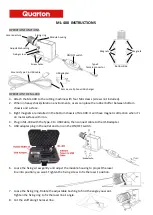
TESTING CONCEPTS AND RECOMMENDED TEST SEQUENCE
20
Summary of Recommended Tests
The testing stages listed above result in large amounts of test data. However, it is important to consider
which tests provide the most benefit in the shortest amount of time. For this situation we recommend
the following simplified and reduced test outline:
Set-Up
1.
Set-up the TALAN prior to making test measurements. Methods for performing these steps
are provided later in the manual.
a.
Enter a Job Name prior to testing.
b.
Enter the Location and Target information.
c.
Define the number of conductors that exist on the line.
d.
Define a Sequence Name.
e.
Install digital phone type (i.e., Avaya, Nortel, Samsung…).
Non-Alerting
2.
Without disconnecting the line or altering the handset, test the line for audio using the
banana plugs.
a.
Find a place somewhere on the line to gain access to the pairs.
b.
Test each pair for voltage to verify the main active pair.
c.
Test each pair for both analog and digital Audio.
d.
Test each pair for carrier current signals with the RF Level & Spectrum tests.
3.
Using the RF Antennas, test for RF energy coming from the telephone.
Single Ended Testing
4.
At the phone set, connect the TALAN in line.
a.
If the Telephone cable is a FLAT cable, then a FLAT patch cable should be used between
the TALAN and the wall jack.
b.
If the Telephone cable is a Twisted Pair cable, a Twisted Pair patch cable (typically CAT5)
should be used between the TALAN and the wall jack.
5.
With the Phone ON HOOK (Stage 1)
a.
Test all pairs for DC voltage to get a basis for operating voltage & DC current.
b.
Test all pair combinations for audio. There should be NO audio.
6.
With the Phone OFF HOOK and a call in progress (Stage 2)
a.
Test all pairs for audio (Note: you may also hear audio on any pair combination that has
either conductor from the main pair because the TALAN audio system can pull audio
from one wire in a balanced pair).
b.
Test all pairs for DC voltage. This gives a basis for the operating voltage.
7.
With the Phone Disconnected (Stage 3)
a.
Classify the Pairs (define balanced pairs).
b.
Test the main pairs with the FDR. Put all FDR traces on the screen and visually compare.
They should be very similar. It is recommended to concentrate only on the balanced
pairs.
Double Ended Testing
8.
With the Phone Set Disconnected and the Switch Disconnected (Stage 4)
a.
Test all pair combinations with the NLJD. There should be NO response on any pair
combinations. THIS IS THE MOST RELIABLE TEST.
9.
With the Phone Set Disconnected, the Switch Disconnected, and the End-Of-Line terminator
placed on the line (Stage 5)
a.
Test main pairs with the FDR to indicate locations of electronic connections.
10.
Use the Locator Probe as needed to find the tap.
















































